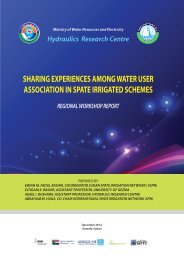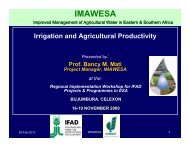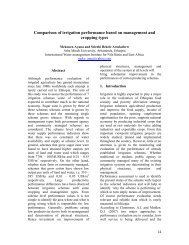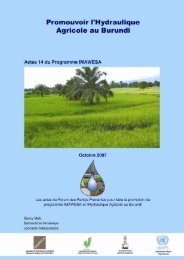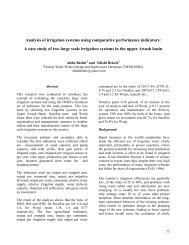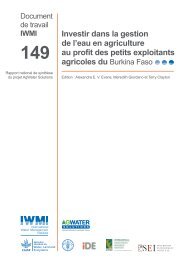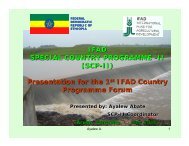Irrigation and Rain-fed Crop Production System in Ethiopia
Irrigation and Rain-fed Crop Production System in Ethiopia
Irrigation and Rain-fed Crop Production System in Ethiopia
Create successful ePaper yourself
Turn your PDF publications into a flip-book with our unique Google optimized e-Paper software.
<strong>Irrigation</strong> <strong>and</strong> <strong>Ra<strong>in</strong></strong>-<strong>fed</strong> <strong>Crop</strong> <strong>Production</strong> <strong>System</strong> <strong>in</strong> <strong>Ethiopia</strong><br />
Tilahun Hordofa 1 , Michael Menkir 2, Sileshi Bekele 2 , Teklu Erkossa 1<br />
1<br />
<strong>Ethiopia</strong>n Institute of Agricultural Research, Addis Ababa, <strong>Ethiopia</strong><br />
2<br />
International Water Management Institute (IWMI) Subregional Office for the Nile Bas<strong>in</strong> <strong>and</strong><br />
East Africa, Addis Ababa, <strong>Ethiopia</strong><br />
tilahun_hordofa@yahoo.com<br />
Abstract<br />
<strong>Crop</strong> production is a function of water,<br />
nutrient, climate <strong>and</strong> soil environment.<br />
Provided that all other requirement are<br />
satisfactorily for proper growth <strong>and</strong><br />
production, ra<strong>in</strong>fall rarely meets the time<br />
with required amount of water application<br />
for plant growth. As a result average yield<br />
of agricultural crops under ra<strong>in</strong>-<strong>fed</strong><br />
agriculture is low compared to irrigated<br />
agriculture. This study assesses irrigation<br />
<strong>and</strong> ra<strong>in</strong>-<strong>fed</strong> agriculture system <strong>in</strong><br />
connection to its potential productivity<br />
under exist<strong>in</strong>g practice. While the ra<strong>in</strong>-<strong>fed</strong><br />
areas considered <strong>in</strong> this study are the<br />
aggregate at the national level, five<br />
systematically selected Medium <strong>and</strong> large<br />
scale irrigation schemes were selected based<br />
on cropp<strong>in</strong>g patter, geographic <strong>and</strong> agro<br />
ecological representation These are<br />
F<strong>in</strong>cha’a, MAAE, Metehara, Sille, <strong>and</strong><br />
UAAIE which are located at three river<br />
bas<strong>in</strong>s, viz, Nile (Abbay), Awash <strong>and</strong> the<br />
Rift valley bas<strong>in</strong>s. Data were collected us<strong>in</strong>g<br />
pre-formulated checklists, through series of<br />
<strong>in</strong>terviews <strong>and</strong> discussions; <strong>and</strong> from<br />
published <strong>and</strong> unpublished documents. The<br />
result <strong>in</strong>dicated that crop production was<br />
undulat<strong>in</strong>g under ra<strong>in</strong>-<strong>fed</strong> agriculture <strong>and</strong> as<br />
a result the performance of ra<strong>in</strong>-<strong>fed</strong><br />
productivity rema<strong>in</strong>ed low <strong>and</strong> stable for<br />
most crops. Although crops grown by smallholder<br />
private farmers are different, cereals<br />
occupy about 74 per cent followed by pulses<br />
<strong>and</strong> oil seeds with small proportion. Dur<strong>in</strong>g<br />
the last one decade, the maximum <strong>and</strong><br />
m<strong>in</strong>imum cultivated l<strong>and</strong> by small-holder<br />
peasant farmers at the national level was<br />
10.7 <strong>and</strong> 6.6 M ha, respectively. Increased<br />
cultivable area by private small-holder<br />
farmers could not seem to contribute to the<br />
<strong>in</strong>creased production. Total irrigated l<strong>and</strong> by<br />
private peasant farmers ranged between 66<br />
<strong>and</strong> 147 thous<strong>and</strong> hectares for the last one<br />
decade. Dur<strong>in</strong>g the last decade the area<br />
under irrigation was steadily <strong>in</strong>creas<strong>in</strong>g for<br />
most of the large scale schemes. Particularly<br />
F<strong>in</strong>cha’a <strong>and</strong> Metehara farms are<br />
significantly <strong>in</strong>creas<strong>in</strong>g while MAAE farm<br />
has shown only a slight <strong>in</strong>crease. At UAAIE<br />
farm, crop production shows a decreas<strong>in</strong>g<br />
trend. Productivity of banana at Sille farm<br />
was decreas<strong>in</strong>g despite its <strong>in</strong>creas<strong>in</strong>g <strong>in</strong> l<strong>and</strong><br />
area.<br />
Key words: <strong>Irrigation</strong>, <strong>Ra<strong>in</strong></strong>-<strong>fed</strong>, crop<br />
production, productivity, large scale scheme,<br />
private small-holder<br />
1. Introduction<br />
<strong>Crop</strong> production is a function of water,<br />
nutrient, climate <strong>and</strong> soil environment.<br />
Complex relationship existed between these<br />
factors <strong>and</strong> the crop as a consequence of the<br />
<strong>in</strong>volvement of biological, physiological,<br />
physical <strong>and</strong> chemical processes. However,<br />
efficient crop production <strong>and</strong> optimum yield<br />
can be achieved only when the water supply<br />
is precisely <strong>in</strong> f<strong>in</strong>e tune with the biological<br />
needs provided that the crop is well supplied<br />
with the required nutrients <strong>and</strong> well adapted<br />
to the prevail<strong>in</strong>g environment. On the other<br />
27
h<strong>and</strong>, there is no crop without water, what so<br />
ever needs are <strong>in</strong> place. Therefore, timely<br />
supplied with an adequate amount of<br />
precipitation <strong>and</strong>/or irrigation could play a<br />
major role <strong>in</strong> <strong>in</strong>creas<strong>in</strong>g agricultural crop<br />
production.<br />
<strong>Ra<strong>in</strong></strong>fall rarely meets the time with required<br />
amount of application for plant growth. As a<br />
result average yield of agricultural crops<br />
under ra<strong>in</strong>-<strong>fed</strong> agriculture is low compared<br />
to irrigation, which is the application of<br />
controlled amount of water at specified time<br />
of application. In <strong>Ethiopia</strong>, traditional ra<strong>in</strong><strong>fed</strong><br />
agriculture is the dom<strong>in</strong>ant form of<br />
farm<strong>in</strong>g <strong>in</strong> which the peasant farm<br />
households contribute the largest proportion<br />
of the total agricultural production. Out of<br />
the total l<strong>and</strong> area of 112.3 M ha, about 16.4<br />
M ha are suitable for the production of<br />
annual <strong>and</strong> perennial crops. Of the estimated<br />
arable l<strong>and</strong>, presently about 10 M ha is used<br />
annually for ra<strong>in</strong>-<strong>fed</strong> crops (CSA, 2006).<br />
The pattern <strong>and</strong> <strong>in</strong>tensity of ra<strong>in</strong>fall <strong>in</strong> the<br />
country is quite variable <strong>in</strong> which most of<br />
the highl<strong>and</strong>s receive between 510 to<br />
1530mm of ra<strong>in</strong> annually <strong>and</strong> <strong>in</strong> typical arid<br />
<strong>and</strong> semi-arid areas generally receive less<br />
than 500mm to about 750mm ra<strong>in</strong>,<br />
respectively. However, ra<strong>in</strong>fall <strong>in</strong> most cases<br />
is unreliable <strong>and</strong> erratic <strong>and</strong> moreover,<br />
productivity is constra<strong>in</strong>ed by several<br />
<strong>in</strong>terl<strong>in</strong>ked factors such as unpredictable<br />
climate (flood, frost, pest etc.) small <strong>and</strong><br />
fragmented l<strong>and</strong> hold<strong>in</strong>g, l<strong>and</strong> degradation,<br />
limited technological <strong>in</strong>puts, etc. About 80<br />
percent of the population lives <strong>in</strong> the<br />
highl<strong>and</strong>s. Over population <strong>in</strong> these area<br />
caused shortage of l<strong>and</strong> <strong>and</strong> thereby push<strong>in</strong>g<br />
the farmers onto l<strong>and</strong>s with fragile soils <strong>and</strong><br />
steep slopes <strong>in</strong> which the l<strong>and</strong> becomes<br />
exposed to erosion <strong>and</strong> eventually turns out<br />
to unproductive state. On the other h<strong>and</strong><br />
there is a huge tract of arable l<strong>and</strong> <strong>in</strong> the low<br />
l<strong>and</strong>s which could be utilized for agricultural<br />
production. However, ra<strong>in</strong>fall is either not<br />
sufficient or not dependable <strong>in</strong> amounts <strong>and</strong><br />
tim<strong>in</strong>g. As a result, crops suffer from severe<br />
soil moisture stress <strong>and</strong> drought.<br />
The dependence on ra<strong>in</strong> has significantly<br />
affected the life of the people <strong>in</strong> particular<br />
<strong>and</strong> economic development of the country <strong>in</strong><br />
general. Improv<strong>in</strong>g this sector contributes to<br />
improve the productivity of agriculture <strong>and</strong><br />
thus the generation of higher <strong>in</strong>comes,<br />
promotion food self-sufficiency <strong>and</strong><br />
improv<strong>in</strong>g health condition of the people. It<br />
also <strong>in</strong>creases <strong>and</strong> diversifies production of<br />
raw materials for <strong>in</strong>dustries <strong>and</strong> promotion<br />
of export item.<br />
<strong>Irrigation</strong> is one means for a good farm<br />
husb<strong>and</strong>ry, better l<strong>and</strong> utilization <strong>and</strong> stable<br />
<strong>and</strong> higher crop production. Susta<strong>in</strong>ed<br />
growth <strong>and</strong> dynamism <strong>in</strong> agriculture is a<br />
fundamental necessity to meet the <strong>in</strong>creas<strong>in</strong>g<br />
dem<strong>and</strong> for food <strong>and</strong> other products <strong>in</strong> view<br />
of the grow<strong>in</strong>g population. Irrigated<br />
agriculture will play a major role <strong>in</strong> reach<strong>in</strong>g<br />
the broader development vision of the<br />
country <strong>in</strong> achiev<strong>in</strong>g food security, poverty<br />
alleviation <strong>and</strong> improvement <strong>in</strong> the quality<br />
of life. The ma<strong>in</strong> objective of irrigated<br />
agriculture is to provide plants with<br />
sufficient water to prevent stress that may<br />
cause reduced yields or poor quality of<br />
harvest (Haise <strong>and</strong> Hagan, 1987; Tayler,<br />
1965).<br />
<strong>Ethiopia</strong> is one of the few African countries<br />
endowed with relatively abundant water<br />
resources, favorable climate <strong>and</strong> potentially<br />
huge irrigable l<strong>and</strong>. The annual stream flow<br />
<strong>and</strong> groundwater resources are estimated<br />
around 122 <strong>and</strong> 2.6 billion m³, respectively.<br />
About 83 percent of the total runoff is found<br />
<strong>in</strong> the bas<strong>in</strong>s of large rivers such as the<br />
Abbay (Blue Nile), the Baro Akobo, the<br />
Omo Gibe <strong>and</strong> the Tekez (MoWR, 2002).<br />
While the potential benefits of irrigation are<br />
great, the actual achievement <strong>in</strong> many<br />
irrigated areas of the country is substantially<br />
less than the potential. Accord<strong>in</strong>g to MoWR<br />
(2005), <strong>Ethiopia</strong> is estimated to have 3.7 M<br />
ha of potentially irrigable area with the<br />
available surface water resources <strong>and</strong> the<br />
l<strong>and</strong> irrigated through the development of<br />
traditional <strong>and</strong> modern irrigation schemes<br />
are estimated to be about 386,603 hectares,<br />
28
which is about 10 per cent of potentially<br />
irrigable l<strong>and</strong>. Accord<strong>in</strong>g to the report, <strong>in</strong> the<br />
modern irrigation there were 466 small, 102<br />
medium <strong>and</strong> 9 large irrigation schemes with<br />
the total area coverage of 28,939, 71,924<br />
<strong>and</strong> 49,675 ha, respectively have been<br />
developed by Government,<br />
nongovernmental organizations <strong>and</strong> private<br />
<strong>in</strong>vestors. However, the major crops<br />
produced with irrigation are <strong>in</strong>dustrial <strong>and</strong><br />
cash crops with small proportion of food<br />
crops. The major part of food crops<br />
produced <strong>in</strong> the country come from ra<strong>in</strong>-<strong>fed</strong><br />
agriculture.<br />
This gross underdevelopment has spurred<br />
the <strong>Irrigation</strong> Development Program (IDP)<br />
to put additional hectares of l<strong>and</strong> under<br />
irrigation with<strong>in</strong> its 15-year plan period of<br />
2002-2016 (MoFED, 2006 ). Therefore, a<br />
strategy that ensures economically<br />
profitable, ecologically susta<strong>in</strong>able <strong>and</strong><br />
socially acceptable use of the available<br />
resources (l<strong>and</strong>, water, climate, labor,<br />
f<strong>in</strong>ance) is of paramount importance. This<br />
presumes that the limited resources are<br />
efficiently used so that the benefits per unit<br />
out puts are optimized. Therefore, this study<br />
was aimed to assess irrigation <strong>and</strong> ra<strong>in</strong>-<strong>fed</strong><br />
agriculture system <strong>in</strong> connection to its<br />
potential productivity under exist<strong>in</strong>g<br />
practice.<br />
2. Study Area<br />
The study area encompasses ra<strong>in</strong>-<strong>fed</strong> areas<br />
<strong>in</strong> the country <strong>in</strong> general <strong>and</strong> five<br />
systematically selected Medium <strong>and</strong> large<br />
scale irrigation schemes based on cropp<strong>in</strong>g<br />
patter, geographic <strong>and</strong> agro ecological<br />
representation These are F<strong>in</strong>cha’a, MAAE,<br />
Metehara, Sille, <strong>and</strong> UAAIE which are<br />
located at three river bas<strong>in</strong>s, viz, Nile<br />
(Abbay), Awash <strong>and</strong> the Rift valley bas<strong>in</strong>s.<br />
The ma<strong>in</strong> features of the study sites are<br />
presented <strong>in</strong> Table 1.<br />
Table 1 Ma<strong>in</strong> features of selected irrigation schemes<br />
<strong>Irrigation</strong> Schemes<br />
Features F<strong>in</strong>cha MAAI MSF UAAIE Sille SF<br />
River bas<strong>in</strong> Abbay Awash Awash Awash Rift valley<br />
Latitude 9 o 18’N 9 o 46’N 8 o 52’N 8 o 37’N 6 o 1’N<br />
Longitude 37 o 14’E 40 o 38’E 39 o 54’E 39 o 43’E 37 o 37’E<br />
Altitude (m) 1450 750 950 1100-1200 1280<br />
Tmax ( 0 C) 24 34 33.1 32.6 32<br />
Tm<strong>in</strong> ( 0 C) 7.4 18 17.2 15.3 17<br />
<strong>Ra<strong>in</strong></strong>fall (mm) 1300 500 550 500 729.6<br />
<strong>Crop</strong>s Sugarcane Cotton Sugar (fruits) vegetables<br />
<strong>and</strong> fruits<br />
cotton,<br />
maize <strong>and</strong><br />
banana<br />
Source of water F<strong>in</strong>cha’a River Awash River Awash River Awash River Sille River<br />
Method of Spr<strong>in</strong>kler Surface Surface<br />
Surface<br />
irrigation<br />
(furrow) (furrow)<br />
(furrow)<br />
Surface<br />
(furrow <strong>and</strong><br />
bas<strong>in</strong>)<br />
29
3. Methodology<br />
In this study status of ra<strong>in</strong>-<strong>fed</strong> <strong>and</strong> irrigated<br />
agriculture <strong>in</strong> terms of area, production <strong>and</strong><br />
productivity will be assessed at national <strong>and</strong><br />
River bas<strong>in</strong> level. Primary data (crop<br />
production <strong>and</strong> productivity, irrigated <strong>and</strong><br />
ra<strong>in</strong>-<strong>fed</strong> area etc) were collected us<strong>in</strong>g preformulated<br />
checklists for time span of at<br />
least ten years. Series of <strong>in</strong>terviews <strong>and</strong><br />
discussions were held with different<br />
stakeholders <strong>in</strong>clud<strong>in</strong>g; representatives of<br />
water user associations <strong>and</strong> beneficiaries,<br />
subject matter specialists from zonal <strong>and</strong><br />
district BoARD (agronomists, irrigation <strong>and</strong><br />
natural resource experts, extension<br />
personnel etc) for the small scale irrigation<br />
schemes <strong>and</strong> the correspond<strong>in</strong>g ra<strong>in</strong>-<strong>fed</strong><br />
agriculture system. Similarly <strong>in</strong>terviews <strong>and</strong><br />
discussions were also held with enterprise,<br />
farm <strong>and</strong> unit managers of the selected large<br />
scale irrigation schemes. In addition,<br />
published <strong>and</strong> unpublished documents<br />
(series of agricultural sample survey reports<br />
(CSA) were reviewed <strong>and</strong> analyzed.<br />
4. Results <strong>and</strong> Discussion<br />
<strong>Ra<strong>in</strong></strong>-<strong>fed</strong> Farm<strong>in</strong>g <strong>System</strong><br />
<strong>Ethiopia</strong>n farm<strong>in</strong>g is ma<strong>in</strong>ly dependant on<br />
ra<strong>in</strong>-<strong>fed</strong> smallholder agriculture system as a<br />
means of food <strong>and</strong> <strong>in</strong>come for its population.<br />
Virtually all food crops come from ra<strong>in</strong>-<strong>fed</strong><br />
agriculture system. The farm<strong>in</strong>g societies are<br />
pr<strong>in</strong>cipally private peasant. <strong>Crop</strong>s grown<br />
under ra<strong>in</strong>-<strong>fed</strong> farm<strong>in</strong>g system were diverse<br />
<strong>and</strong> many with<strong>in</strong> a cropp<strong>in</strong>g season.<br />
However, the agriculture system is<br />
dom<strong>in</strong>ated by cereal based productions s<strong>in</strong>ce<br />
it was produced <strong>in</strong> large quantity as<br />
compared to other crops (Fig. 1). Pulses <strong>and</strong><br />
oil seeds occupy small proportion <strong>in</strong> contrast<br />
to cereals. The major cereal crops gown<br />
were maize, sorghum, tef, wheat <strong>and</strong> barley.<br />
Oil seeds<br />
7%<br />
Fruits<br />
0.4%<br />
Root crops<br />
2%<br />
Vegetables<br />
1%<br />
Chat<br />
1%<br />
Hops<br />
0.2%<br />
Sugar cane<br />
0.2%<br />
Coffee<br />
2.6%<br />
Pulses<br />
12%<br />
5<br />
074%<br />
Fig. 1 Area coverage of ra<strong>in</strong>-<strong>fed</strong> crops<br />
30
Cereal production <strong>and</strong> productivity under<br />
ra<strong>in</strong>-<strong>fed</strong> agriculture is shown <strong>in</strong> figure 2. The<br />
crop production was undulat<strong>in</strong>g reach<strong>in</strong>g<br />
low dur<strong>in</strong>g 1995/96 <strong>and</strong> 2005/06; <strong>and</strong> pick<br />
dur<strong>in</strong>g 2001/02. As shown <strong>in</strong> Fig. 3, area<br />
under ra<strong>in</strong>-<strong>fed</strong> agriculture was highest<br />
dur<strong>in</strong>g 2005/06 cropp<strong>in</strong>g season <strong>and</strong> where<br />
as production is low as compared to 200/01<br />
cropp<strong>in</strong>g season.<br />
Dur<strong>in</strong>g the last one decade, the maximum<br />
<strong>and</strong> m<strong>in</strong>imum cultivated l<strong>and</strong> by smallholder<br />
peasant farmers at the national level<br />
was 10.7 <strong>and</strong> 6.6 M ha, respectively (fig. 3).<br />
Agricultural production could be <strong>in</strong>creased<br />
through <strong>in</strong>creas<strong>in</strong>g cultivable area or us<strong>in</strong>g<br />
improved seed <strong>and</strong> cultural practices<br />
(fertilizer, irrigation etc). The <strong>in</strong>creased<br />
cultivable area dur<strong>in</strong>g 2005/06 by private<br />
small-holder farmers could not seem to<br />
contribute to the <strong>in</strong>creased production. The<br />
production rather seems to fall as the area<br />
<strong>in</strong>creased. There can be several reasons for<br />
low production. Simple reason for <strong>in</strong>creased<br />
crop production dur<strong>in</strong>g 2001/02 could be<br />
due to an <strong>in</strong>crease <strong>in</strong> cultivable area along<br />
with the favorable conditions <strong>in</strong>clud<strong>in</strong>g<br />
adequate ra<strong>in</strong>fall that might have occurred<br />
dur<strong>in</strong>g the cropp<strong>in</strong>g season. Moreover,<br />
visual observation elucidated that the<br />
occurrence of sufficient ra<strong>in</strong>fall (adequacy<br />
<strong>and</strong> reliability) through-out the grow<strong>in</strong>g<br />
season enables the private peasant farmers to<br />
get bumper harvest, <strong>in</strong>dicat<strong>in</strong>g ra<strong>in</strong>-<strong>fed</strong><br />
agriculture to depend strongly on ra<strong>in</strong>fall<br />
availability. In absence of sufficient ra<strong>in</strong>fall,<br />
there is always low agricultural production<br />
thereby creat<strong>in</strong>g food shortage <strong>and</strong> food<br />
<strong>in</strong>security for its population <strong>and</strong> also dipp<strong>in</strong>g<br />
poverty. Consequently, the performance of<br />
ra<strong>in</strong>-<strong>fed</strong> agricultural production <strong>and</strong><br />
productivity rema<strong>in</strong>ed low <strong>and</strong> stable for<br />
most of the years. The low level of<br />
performance of ra<strong>in</strong>-<strong>fed</strong> agriculture could<br />
not only be attributed to erratic nature of<br />
ra<strong>in</strong>fall but also deteriorat<strong>in</strong>g soil fertility<br />
<strong>and</strong> slow adoption <strong>and</strong>/or lack of appropriate<br />
technologies.<br />
3500.00<br />
35.00<br />
<strong>Production</strong><br />
3000.00<br />
2500.00<br />
2000.00<br />
1500.00<br />
1000.00<br />
500.00<br />
0.00<br />
-500.00<br />
Barley<br />
maize<br />
sorghum<br />
Tef<br />
wheat<br />
Barley<br />
maize<br />
sorghum<br />
Tef<br />
wheat<br />
Barley<br />
maize<br />
sorghum<br />
Tef<br />
wheat<br />
Barley<br />
maize<br />
sorghum<br />
Tef<br />
wheat<br />
Barley<br />
maize<br />
sorghum<br />
Tef<br />
wheat<br />
Barley<br />
maize<br />
sorghum<br />
Tef<br />
wheat<br />
Barley<br />
maize<br />
sorghum<br />
Tef<br />
wheat<br />
Barley<br />
maize<br />
sorghum<br />
Tef<br />
wheat<br />
Barley<br />
maize<br />
sorghum<br />
Tef<br />
wheat<br />
Barley<br />
maize<br />
sorghum<br />
Tef<br />
wheat<br />
30.00<br />
25.00<br />
20.00<br />
15.00<br />
10.00<br />
5.00<br />
0.00<br />
Productivity<br />
1995/96 1996/97 1997/98 1998/99 1999/00 2000/01 2001/02 2003/04 2004/05 2005/06<br />
Year<br />
<strong>Production</strong>, '000 ton<br />
Productivity, q/ha<br />
Fig. 2 <strong>Production</strong> <strong>and</strong> productivity of ra<strong>in</strong>-<strong>fed</strong> agriculture<br />
The above statements generally po<strong>in</strong>t out<br />
that those small-holder private farmers<br />
survived with uncerta<strong>in</strong>ty of ra<strong>in</strong>fall <strong>and</strong> low<br />
level of technology aggravat<strong>in</strong>g the<br />
31
occurrence of poverty <strong>and</strong> food <strong>in</strong>security.<br />
With the exist<strong>in</strong>g rate of production <strong>and</strong><br />
productivity, it is go<strong>in</strong>g to be a challenge<br />
<strong>and</strong> threat to the country to feed the ever<br />
rapidly grow<strong>in</strong>g population. Therefore, due<br />
attention should be given to improve the<br />
production system to alleviate poverty <strong>and</strong><br />
secure food self-sufficiency.<br />
<strong>Irrigation</strong> Farm<strong>in</strong>g <strong>System</strong><br />
<strong>Irrigation</strong> enables farmers to improve crop<br />
production <strong>and</strong> <strong>in</strong>tensification thereby<br />
susta<strong>in</strong><strong>in</strong>g <strong>and</strong> improv<strong>in</strong>g livelihoods <strong>and</strong><br />
food security. In <strong>Ethiopia</strong>, private peasant<br />
farmers use irrigation at small scale level to<br />
enable them <strong>in</strong>crease crop production <strong>and</strong> as<br />
a means of rais<strong>in</strong>g <strong>in</strong>come. Small scale<br />
irrigation not only <strong>in</strong>crease crop production,<br />
but also improves cropp<strong>in</strong>g <strong>in</strong>tensity <strong>and</strong><br />
reduces the effect of erratic ra<strong>in</strong>fall. The<br />
practice of irrigation may not be possible for<br />
every farmer <strong>and</strong> could not be possible to<br />
exp<strong>and</strong> the area. As shown <strong>in</strong> figure 3,<br />
dur<strong>in</strong>g the last one decade, the total irrigated<br />
l<strong>and</strong> by private peasant farmers ranged<br />
between 63 <strong>and</strong> 175 thous<strong>and</strong> hectares<br />
which is 0.8 to 1.8 per cent of the total area<br />
covered under ra<strong>in</strong>-<strong>fed</strong> agriculture,<br />
respectively.<br />
12000000<br />
<strong>Ra<strong>in</strong></strong><strong>fed</strong><br />
Irrigated<br />
Area (ha)<br />
10000000<br />
8000000<br />
6000000<br />
7948530<br />
8072360<br />
6649500<br />
8016310<br />
8210000<br />
10435370<br />
9892611<br />
9361560<br />
10268921<br />
10680886<br />
4000000<br />
2000000<br />
84640<br />
68210<br />
63640<br />
63170<br />
81140<br />
81690<br />
175736<br />
120643<br />
121493<br />
146871<br />
0<br />
95/96 96/97 97/98 98/99 99/00 00/01 01/02 03/04 04/05 05/06<br />
Year<br />
Fig. 3 <strong>Ra<strong>in</strong></strong>-<strong>fed</strong> <strong>and</strong> irrigated area under small-holders<br />
32
The area under small scale irrigation has<br />
been appreciably exp<strong>and</strong><strong>in</strong>g, particularly<br />
after 2001/02 though apparently shown to<br />
decl<strong>in</strong>e dur<strong>in</strong>g 2003/04.<br />
Year<br />
Table 2. Irrigated area under small-holder private farmers (ha)<br />
Cereals<br />
Permanent<br />
Teff Barley Wheat Maiz Sorghum Total Pulses Oil seeds Others crops<br />
e<br />
2005/06 7895 7441 6116 3558 15596 73509 3950 1740 30170 37502<br />
6<br />
2004/05 7756 7212 4614 2940 9756 59052 6832 1915 16143 34361<br />
7<br />
2003/04 7835 5647 3805 3257 11199 61406 5217 927 21578 31516<br />
3<br />
2001/02 1244 8016 4750 5383 12778 93615 9896 726 35855 33359<br />
7<br />
8<br />
2000/01 5650 3680 1330 1896 15910 45770 3880 290 9240 22500<br />
0<br />
1999/00 5230 4630 1780 1856 11510 42850 2890 430 13390 21580<br />
0<br />
1998/99 2890 3580 2570 1365 7240 30110 2660 ** 8830 21350<br />
0<br />
1997/98 1154 4230 2540 1214 3690 34560 1920 ** 7350 18860<br />
0<br />
0<br />
1996/97 4790 ** 800 1369 18970 39220 ** ** 3650 21470<br />
0<br />
1995/96 4490 1400 1890 2181 ** 55050 5300 ** 4890 1933<br />
0<br />
** not reported<br />
The ma<strong>in</strong> agricultural produces under small<br />
scale irrigation <strong>in</strong>cludes cereals, pulses, oil<br />
seeds <strong>and</strong> permanent crops like fruits, chat,<br />
coffee, hopes <strong>and</strong> sugarcane. Permanent<br />
crops occupy the largest share next to<br />
cereals. Pulses <strong>and</strong> oil seeds occupy (5 %)<br />
<strong>in</strong>significant part compared to permanent<br />
crops. The major irrigated pulse crops<br />
<strong>in</strong>clude field pea, horse bean, haricot bean<br />
<strong>and</strong> chick pea. Major irrigated oil seeds<br />
<strong>in</strong>clude neug, l<strong>in</strong>seeds <strong>and</strong> sesame. Others<br />
like vegetables <strong>and</strong> root crops are produced<br />
<strong>in</strong> small proportion. Among cereals crops,<br />
maize covers the maximum area under small<br />
scale irrigation followed by sorghum, tef,<br />
barley <strong>and</strong> wheat (Table 2).<br />
In contrary to small scale irrigation, Medium<br />
<strong>and</strong> large scale irrigation schemes <strong>in</strong> the<br />
country has been found to produce ma<strong>in</strong>ly<br />
cash <strong>and</strong> <strong>in</strong>dustrial crops. The schemes<br />
considered this <strong>in</strong> study are government<br />
owned enterprises. Medium <strong>and</strong> large scale<br />
irrigation schemes are usually expected to<br />
contribute to the national economic growth<br />
<strong>and</strong> alleviation of poverty <strong>and</strong> food security.<br />
However, the contribution of these schemes<br />
to food crops production is almost none. The<br />
major crops grown under medium <strong>and</strong> large<br />
33
scale irrigation <strong>in</strong>clude Sugarcane, cotton,<br />
fruits <strong>and</strong> vegetables. Figures 4 to 6 show<br />
area, production <strong>and</strong> productivity of<br />
Medium <strong>and</strong> large scale irrigated agriculture<br />
schemes. Dur<strong>in</strong>g the last one decade the area<br />
under irrigation was steadily <strong>in</strong>creas<strong>in</strong>g for<br />
most of medium <strong>and</strong> large scale schemes<br />
(Fig.4). Particularly F<strong>in</strong>cha’a <strong>and</strong> Metehara<br />
farms are significantly <strong>in</strong>creas<strong>in</strong>g while<br />
MAAE farm has shown only a slight<br />
<strong>in</strong>crease. Ma<strong>in</strong>ly due to re-occupation of<br />
part of the l<strong>and</strong>s by the local people, Sille<br />
farm has shown a decl<strong>in</strong>e <strong>in</strong> irrigated l<strong>and</strong><br />
area. . Similarly, crop production, has shown<br />
an <strong>in</strong>creas<strong>in</strong>g trend for most of the irrigation<br />
schemes (Fig. 5). Sugar cane production is<br />
<strong>in</strong>creas<strong>in</strong>g significantly at F<strong>in</strong>cha’a <strong>and</strong><br />
Metehara while banana production is<br />
<strong>in</strong>creas<strong>in</strong>g significantly at Sille farm.<br />
However at UAAIE farm, crop production<br />
shows a decreas<strong>in</strong>g trend. At Sille farm<br />
cotton production shows a decreas<strong>in</strong>g trend<br />
ma<strong>in</strong>ly the replacement of some of the<br />
cotton field by banana. This was attributed<br />
ma<strong>in</strong>ly to market problems s<strong>in</strong>ce there are<br />
no competent purchasers of the products <strong>in</strong><br />
the area, <strong>and</strong> transportation cost is too high<br />
to move to other areas. Consequently, the<br />
farm has become price recipient, <strong>in</strong>stead of<br />
negotiat<strong>in</strong>g for a reasonable price.<br />
Productivity is <strong>in</strong>creas<strong>in</strong>g better at MAAE<br />
farm only while at Metehara <strong>and</strong> sille farms<br />
the trend is stable. Productivity has been<br />
decl<strong>in</strong><strong>in</strong>g at UAAIE <strong>and</strong> F<strong>in</strong>cha farms, but<br />
attempts are made to compensate by<br />
<strong>in</strong>crease <strong>in</strong> cultivated l<strong>and</strong> area. While the<br />
productivity of banana at Sille farm was<br />
decreas<strong>in</strong>g despite its <strong>in</strong>creas<strong>in</strong>g <strong>in</strong> l<strong>and</strong><br />
area, the overall productivity of Sille farm is<br />
unstable, which may be among the reasons<br />
for cont<strong>in</strong>uous change of crop types.<br />
12.00<br />
10.00<br />
Area <strong>in</strong> '000 ha<br />
8.00<br />
6.00<br />
MAAE<br />
Sille<br />
F<strong>in</strong>cha<br />
UAAIE<br />
Metehara<br />
4.00<br />
2.00<br />
0.00<br />
1993 1994 1995 1996 1997 1998 1999 2000 2001 2002 2003 2004 2005 2006<br />
Year<br />
Fig. 4 Trend of irrigated area under medium <strong>and</strong> large-scale irrigation schemes<br />
34
9000<br />
8000<br />
7000<br />
MAAE ('00 q)<br />
Sbanana (q)<br />
Scotton (q)<br />
Smaize (q)<br />
F<strong>in</strong>cha ('000 t)<br />
UAAIE ('00 q)<br />
Metehara ('000 t)<br />
6000<br />
<strong>Production</strong><br />
5000<br />
4000<br />
3000<br />
2000<br />
1000<br />
0<br />
1993 1994 1995 1996 1997 1998 1999 2000 2001 2002 2003 2004 2005 2006<br />
Year<br />
Fig. 5 Trend of agricultural production under medium <strong>and</strong> large-scale irrigation schemes<br />
120.0<br />
Productivity<br />
100.0<br />
80.0<br />
60.0<br />
MAAE (q/ha)<br />
Sbanana (t/ha)<br />
SCotton (q/ha)<br />
Smaize (q/ha)<br />
F<strong>in</strong>cha (00q/ha)<br />
UAAIE (t/ha)<br />
Metehara (000q/ha)<br />
40.0<br />
20.0<br />
0.0<br />
1993 1994 1995 1996 1997 1998 1999 2000 2001 2002 2003 2004 2005 2006<br />
Year<br />
Fig. 6 Trend of productivity of irrigated agriculture under medium <strong>and</strong> large-scale schemes<br />
35
5. Conclusion<br />
In <strong>Ethiopia</strong>, crop production is dom<strong>in</strong>ated by<br />
traditional ra<strong>in</strong>-<strong>fed</strong> agriculture. However,<br />
ra<strong>in</strong>fall is unreliable <strong>and</strong> erratic <strong>in</strong> nature. As<br />
a result, production <strong>and</strong> productivity is low<br />
<strong>and</strong> stable. Dur<strong>in</strong>g the last one decade, the<br />
maximum <strong>and</strong> m<strong>in</strong>imum cultivated l<strong>and</strong> by<br />
small-holder peasant farmers at the national<br />
level was 10.7 <strong>and</strong> 6.6 M ha, respectively.<br />
<strong>Crop</strong>s grown are ma<strong>in</strong>ly cereals occupy<strong>in</strong>g<br />
about 74 per cent followed by pulses <strong>and</strong> oil<br />
seeds <strong>in</strong> small proportion. The major cereal<br />
crops gown were maize, sorghum, tef, wheat<br />
<strong>and</strong> barley. However, ra<strong>in</strong>-<strong>fed</strong> agriculture<br />
does not seem to meet the ever ris<strong>in</strong>g<br />
dem<strong>and</strong> for food as population <strong>in</strong>creased.<br />
Hence, requires special focus on ways of<br />
<strong>in</strong>creas<strong>in</strong>g production <strong>and</strong> productivity.<br />
Private peasant farmers use irrigation at<br />
small scale level to enable them <strong>in</strong>crease<br />
crop production <strong>and</strong> as a means of rais<strong>in</strong>g<br />
<strong>in</strong>come. Area under small scale irrigation has<br />
been appreciably exp<strong>and</strong><strong>in</strong>g, particularly<br />
after 2001/02. Dur<strong>in</strong>g the last one decade,<br />
the total irrigated l<strong>and</strong> by private peasant<br />
farmers ranged between 63 <strong>and</strong> 175 thous<strong>and</strong><br />
hectares which is 0.8 to 1.8 per cent of the<br />
total area covered under ra<strong>in</strong>-<strong>fed</strong> agriculture,<br />
respectively. Cereals <strong>and</strong> permanent crops<br />
occupy the major part followed by<br />
vegetables <strong>and</strong> root crops.<br />
The contribution of medium <strong>and</strong> large scale<br />
irrigation to food crops is almost negligible.<br />
The schemes produce ma<strong>in</strong>ly <strong>in</strong>dustrial,<br />
exportable <strong>and</strong> cash crops of which<br />
sugarcane, cotton, fruits <strong>and</strong> vegetables are<br />
the major once. In most cases, the area under<br />
medium <strong>and</strong> large scale irrigation schemes<br />
was steadily <strong>in</strong>creas<strong>in</strong>g except at MAAE <strong>and</strong><br />
Sille farm. At UAAIE production <strong>and</strong><br />
productivity were decl<strong>in</strong><strong>in</strong>g while Sille farm<br />
production is generally decl<strong>in</strong><strong>in</strong>g <strong>and</strong><br />
productivity was unstable. <strong>Crop</strong> productivity<br />
was decl<strong>in</strong><strong>in</strong>g at F<strong>in</strong>cha’a farm, better at<br />
MAAE farm <strong>and</strong> stable at Metehara.<br />
References<br />
CSA (Central Statistical Agency) 2006.<br />
Statistical Abstract. Federal Democratic<br />
Republic of <strong>Ethiopia</strong> Central Statistical<br />
Agency, Addis Ababa, <strong>Ethiopia</strong>.<br />
Haise, H.A. <strong>and</strong> Hagan, R.M. 1967. Soil,<br />
Plant <strong>and</strong> evaporative measurement as<br />
criteria for schedul<strong>in</strong>g irrigation. Pp 577<br />
– 604. In: <strong>Irrigation</strong> of Agricultural<br />
l<strong>and</strong>s. R. M. Hagan, H.R. haise <strong>and</strong> T.W.<br />
Edm<strong>in</strong>ster (ed), Monog. Am. Soc.<br />
Agron. Medison, WI.<br />
MoFED (M<strong>in</strong>istry of F<strong>in</strong>ance <strong>and</strong> Economic<br />
Development). 2006. A plan for<br />
Accelerated <strong>and</strong> susta<strong>in</strong>ed Development<br />
to End poverty (PASDEP): <strong>Ethiopia</strong>,<br />
build<strong>in</strong>g <strong>in</strong> progress. Volume 1 ma<strong>in</strong><br />
report. Federal Democratic Republic of<br />
<strong>Ethiopia</strong>, M<strong>in</strong>istry of f<strong>in</strong>ance <strong>and</strong><br />
economic development, Addis Ababa<br />
MoWR (M<strong>in</strong>istry of Water Resources).<br />
2002. Water sector development<br />
programme 2002-2016, Volume II: Ma<strong>in</strong><br />
Report. Federal Democratic Republic of<br />
<strong>Ethiopia</strong>, M<strong>in</strong>istry of Water Resources,<br />
Addis Ababa.<br />
MoWR (M<strong>in</strong>istry of Water Resources).<br />
2005. <strong>Irrigation</strong> (Potential) <strong>in</strong> <strong>Ethiopia</strong>.<br />
<strong>Irrigation</strong> <strong>and</strong> Dra<strong>in</strong>age Development<br />
Studies Department, Federal Democratic<br />
Republic of <strong>Ethiopia</strong>, M<strong>in</strong>istry of Water<br />
Resources, Addis Ababa.<br />
Taylor, S. A. 1965. Manag<strong>in</strong>g irrigation<br />
water on farm. Trans. ASAE; 8:433-436<br />
36



